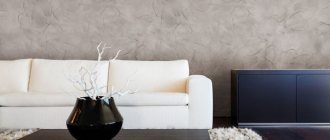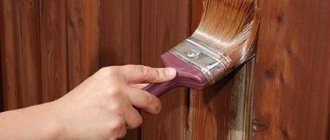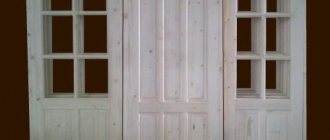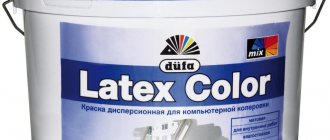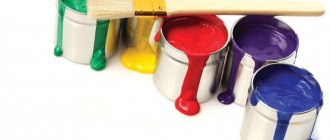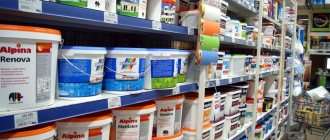With the passage of time, things often become unusable. This also applies to interior doors, which also deteriorate or have an unpresentable appearance. You can restore an old door leaf yourself in several ways. It is worth considering the type of material, degree of wear and financial capabilities. A door made of veneer can be easily confused with products made of natural wood, but the former are much lighter. Considering the manufacturing technology, restoration will not cause problems.
Painted doors
Is it possible to paint a veneer door?
Veneer is a very demanding material . You immediately need to decide whether to leave the solid wood or completely repaint the door in a different color.
First you need to cover up all existing unevenness with a special primer.
Veneered doors can be painted with polyurethane, water-based or glypthal paints.
Nitro paints are not used - they do not tolerate moisture, and your doors may become covered with dull spots. Water-based paints are the most suitable option in this case.
Wait until the primer is completely dry and start painting.
Painting the door
During operation, the coating on laminated sheets gradually wears off, this is especially noticeable near the handle. To update the canvas and make it more attractive, a laminated interior door can be painted. This is quite difficult to do on your own; you should take the preparatory stage responsibly.
To restore the sash, you will need white spirit and enamel grade PF 115; PF 226 is also suitable. In general, all paints intended for wood are suitable for painting a laminated sash. The only exception is water-dispersed. For application you need a brush or roller. You will also need putty and a spatula for it, rags and sandpaper of different sizes.
The painting scheme is as follows:
- Preparing the surface for painting. Before painting a laminated door a different color, the canvas must be washed, any dirt removed from the surface and dried thoroughly. Using coarse sandpaper, sand the areas where there are the most noticeable scratches and defects. After that, remove dust from the surface of the door.
- Puttying. The putty can be applied in 1 or 2 layers so that the coating is even. If the treatment takes place in several layers, then each subsequent one can be applied only after the previous one has completely dried. When the putty has dried well, use fine-grained sandpaper to level its surface. After this treatment, wipe the sash with a cloth. The surface must be rough to ensure paint adhesion.
- Treatment with white spirit. This is a mandatory step before painting any surface.
- Coloring. Depending on the consistency of the paint and personal preferences, you can use a roller or paint brushes, or, if possible, a spray gun, to paint a laminated door. The paint must be distributed evenly, without gaps, but also without sagging. If the canvas is covered with enamel in several layers, then it can be diluted to a more liquid consistency using white spirit. After the door is painted, you need to let the composition dry completely. Then apply another coat of coating.
Before you paint a laminated door with your own hands, it must be removed from its hinges and placed on a table or floor. It is easier to work with it in a horizontal position. It is also necessary to remove all fittings (handles, linings) before painting, and after the finish has dried, install the fittings in place. One or more layers of varnish can be applied over the paint to give it a more durable and glossy finish.
If there are deep cracks on the surface of the laminated door, then a special hard putty should be used for them. It is sold in the form of a bar and is applied using a heated tool or a gas burner, since it must be melted. In this state, cover the crack with putty and leave until dry. Remove excess material and polish with sandpaper.
How to paint MDF doors?
To paint such doors, you can safely use compositions containing varnish and tone in one ( Lakobeits, for example ).
This will help maintain the structure of the door, and at the same time it will have a pleasant appearance. The consistency of Lakobeits is liquid, so it penetrates deeply into the pores of MDF, filling them and forming a uniform, thin and moisture-repellent layer.
Conveniently, the tone and varnish are mixed together, so the door does not need to be tinted first and then varnished.
Since this door has a specific panel pattern, and when painting with a roller or spray gun it is very difficult to achieve uniform varnish coverage, painting should only be done by a professional .
No special skills are required for painting with a brush. You just need to be careful and immediately remove small smudges.
It is quite easy to prepare MDV doors for painting. You just need to thoroughly wipe the doors with a damp sponge or cloth so that there are no unnecessary particles on the surface.
We make soundproofing of interior doors with our own hands. More details.
A beautiful option for decorating doorways with decorative stone is written here.
If you have sliding doors, find out how to choose fittings for them.
How to paint furniture yourself at home?
Restoring wooden furniture is a task accessible not only to professionals and specialized workshops.
Painting furniture with your own hands is real and simple. Updating old furniture is a great idea that will not only save money, but also create original furniture for a modern interior and enjoy your own work. Every craftsman knows the subtleties of working with wooden surfaces, and we will introduce you to some of them. This technology is suitable for various wood-based surfaces, chipboards and veneers.
Painting paneled doors
Today, there are two most popular methods of painting paneled doors.
- One of them is to apply paint first to the door ends themselves. Next, you need to carefully clean the damaged areas of the panel and carefully apply a new layer of primer. After it has dried, you can safely apply paint, preferably in two layers.
- But the application of varnish or stain on these doors must be carried out strictly according to the manufacturer’s instructions. This method is mainly used for doors with a smooth surface.
- Another method is to tint the door panel. It should be used if the surface has a wood texture.
Any surface should be painted only with high-quality fabrics or brushes.
Rules for choosing paint for interior veneer doors
It is advisable to choose a paint that does not cover the grain of the wood.
Paint for veneered doors should be environmentally friendly, resistant to moisture, and most importantly, not cover the beautiful texture of the material.
To paint interior veneer doors, you can use the following compositions:
- Griftal. They belong to the professional category. They are expensive, but easy to apply; one coat is enough to create a smooth and glossy surface.
- Water-dispersed. The most common and popular solutions in everyday life. You need to take products with polymer additives that make the finish coating resistant to moisture.
- Polyurethane. The paint has high adhesion, resistance to moisture, but immunity to ultraviolet radiation. It is advisable to use in places where there is no direct sunlight.
- For humid environments. The best option is acrylic-based compositions. Painting with these materials is resistant, durable and provides excellent protection against high humidity.
The choice of mixture determines the scope of work on preparation for their application and further maintenance during operation. It is better not to pay attention to the price, since this criterion directly determines the quality of the product.
How to paint an iron door?
In this case, you will have to face a number of problems, because the iron door is capricious in terms of painting.
There are also big problems with choosing paint. You should not experiment with interior paints - they will not paint iron doors well.
A much greater effect in this regard will be from PF paint . Although its color scheme is too simple, it will not add any gloss or shine, but will almost completely paint over the door.
For painting, use a spray bottle - this will simplify the work.
Primed doors for painting
Perhaps the easiest way . The doors are almost completely ready for painting; all that remains is to prepare the necessary paint and tools.
Use a brush on uneven surfaces of the door pattern, and a roller on flat surfaces.
You need to be more careful with doors that have glass inserted into them. Pre-glue the glass edges with paper tape to prevent paint from getting on them.
You can learn about soundproofed metal entrance doors from this article.
Here we talk about the correct choice of door handles for interior doors.
And here is about how to repair them.
All information about doors is in this category - https://ru-remont.com/dveri
Furniture decoration
Decor using decoupage method
Painting using an interesting decoupage technique can radically change the appearance of furniture elements. The price of materials for implementing this method is low, but the visual effect is simply amazing.
To implement such coverage you will need:
- PVA or specialized decoupage glue;
- Scissors;
- Three-layer napkins with a pattern printed on their surface. You can replace napkins with fabric, photographs, postcards, specialized cards or other images.
Painting metal doors
If you want to improve the appearance of a metal door, you can paint it.
How to paint a metal door?
First you need to remember some rules .
First of all, before painting, you must thoroughly wipe the door with a sponge soaked in solvent or gasoline.
Welding seams can be removed with a metal brush or a special file. Next, the surface of the door must be coated with a primer, which slows down corrosion and serves as a binder for the paint to the surface.
The best paints for such a door are: pentaphthalic, enamel paint and acrylic enamel. Tools: special brush or spray can.
If you are going to paint a smooth door, then you need to divide the entire surface into small squares and start painting from the upper left corner. The paint must be applied in three layers . In the case where the surface is embossed, painting is carried out from the inside to the outside.
Painting doors. Varnish
This category of materials includes compositions that are often used to consolidate the result after painting with acrylic paint or stain. Varnishes are transparent and tinted. The former are ideal for emphasizing the natural texture of wood, the latter for adding a slight shade and shine.
Varnish is used not only for decorative purposes; it is necessary when the surface of a wooden product needs to be protected from external adverse factors.
There are several types of varnish:
- Alkyd. Just like paint from this group, it creates a durable coating that is resistant to temperature fluctuations and has water-repellent properties.
- Acrylic. The material is resistant to high humidity and does not deteriorate under the influence of ultraviolet rays. It has no pungent odor and comes in glossy or matte finishes.
- Nitrocellulose. Painting interior doors with this composition is possible only in dry rooms with an optimal microclimate, since the resulting coating does not have sufficient strength and can quickly crack.
- Polyurethane. It has good adhesion to wooden surfaces and is characterized by the strength and durability of the coating. Available in glossy, semi-gloss and matte. Not only doors, but also veneer, countertops and even parquet can be coated with this varnish.
- Polyester. It has high strength and wear resistance, but is toxic. It has a strong chemical odor, so it is best used to cover outdoor doors.
How to paint a laminated door?
Because a laminated door has a smooth surface, the paint goes on easily, but it won't last long.
Therefore, first of all, you need to remove the top layer, which has varnish and impregnation, using a grinding machine and zero-grade sandpaper.
You also need to remember that after the protective layer there is a chipboard , which will easily begin to crumble if you do deep enough processing.
The treated surface must be thoroughly wiped with a solvent and a layer of a mixture of antiseptic and primer applied. Let this protective layer dry thoroughly and feel free to begin applying the first coat of paint.
Any paint will do , because after sanding you will have a regular chipboard that can be painted with any composition.
After a day, apply a layer of transparent varnish, which will serve as protection during operation.
What tools to use for restoration
To paint old wooden furniture you will need:
- synthetic brushes (one wide and one narrow);
- velor roller;
- cuvette or paint tray;
- metal spatula;
- primer similar in composition to the base paint;
- paint , stain or stain;
- wood putty;
- sandpaper;
- paint stripper or sander.
When preparing furniture for restoration, you should update the canopies or tighten the old ones, tighten the missing screws/screws, and strengthen the loose connections.
How and how to paint a veneer door
How often do owners of living space or office space find themselves faced with the need to replace the front or interior door . There are many reasons - from a change in style and design of the entire room, to normal wear and tear. What to do if you have no desire to change an almost new door at all.
How to paint a door ?
The solution is considered to be classic painting, which can “breathe” new life. It would be faster and better to entrust such work to specialists, but you can handle the work on your own. If you paint a panel taking into account the material and the appropriate compositions, the result promises to be more than beautiful.
How to paint a veneer door yourself?
It should be immediately emphasized that, regardless of the material used, each door is painted according to the existing rules:
- First of all, the structure is always removed from its hinges before painting.
- Second, the fittings must be removed from the canvas.
- Third, a variety of auxiliary parts (for example, decorative or glass inserts) are covered (sealed) with a specialized protective film.
- Fourth, a coating that is already outdated is always removed using all sorts of options.
You can see this process in more detail by watching the video...
In itself, such a material, like veneer (photo), is considered quite “capricious” and demanding (especially in comparison with laminate). As practice has shown, veneered doors are brought into the room seven days before the work is carried out - this is done so that the material can get used to the temperature and moisture conditions.
Preparing for coloring
Before you start painting, remove the door from its hinges. In the event that you only need to slightly update the paint layer, this is not necessary. Painting doors in an apartment with your own hands begins with preparing the workplace. The door removed from its hinges is laid horizontally on suitable supports at a height of at least 50 cm from the floor. Ordinary stools are successfully used as supports, on which boards the width of the door leaf are placed. The supports must be covered with a non-slip, lint-free, dense fabric. The door is processed first on one side, then turned over to the other. The first stage of work is removing the layer of old paint. For convenience, all fittings (handles, hinges, etc.) are first removed, and a small amount of cotton wool or rags is placed in the holes. To remove a layer of old paint, use a solvent, a stiff wire brush or sandpaper.
We select the composition in order to paint correctly
The selection of paint is a priority and the required composition must be purchased before work is carried out in the required quantity.
- polyurethane paints,
- aqueous formulations - they are more convenient,
- glypthal,
- compositions for coating with paint at a decent level of moisture,
- other varieties suitable for painting veneer.
Attention! It is not recommended to use nitro paints. The problem is that such compositions react very poorly to excess moisture, which leads to the formation of dull spots on the insulated surface. Moreover, nitro paint is considered toxic and can cause poisoning.
About paint for furniture
There are thousands of recommendations on what paint to paint furniture with, but experts who work with veneer and other wood bases advise choosing water-based acrylic paint. Of the many types for homework, acrylic and thixotropic paint are preferable.
Acrylic paint dries quickly, has no pungent odor, and is easy to apply. The water-based paint is wear-resistant, the acrylic surface is easy to clean and durable. Water-based paint can be diluted with water, if necessary, for example, to achieve a lighter tone.
Masters recommend paying attention to the description for what purposes it is intended. For example, nitro-, glypthal and pentaphthalic paints are suitable for repainting garden and garden furniture, but not suitable for home furniture. The paint is suitable for color selection and tone tinting.
Thixotropic paint has a dense consistency, does not flow and does not leave smudges when applied. It fits perfectly and after drying creates a plastic effect.
To achieve a clear wood pattern effect, you need to use a stain or mordant for coloring. The stain is presented in a wide range of types and has a rich range of natural wood shades. The product has a low impregnation class, approximately 0.3-0.5 mm. The layer can be easily removed with sanding equipment or sandpaper. The effect of stain is still not as natural as that of mordant.
Using stain you can highlight a beautiful wood pattern
The stain gives the effect of a natural finish; you can hardly tell that the surface is painted. The mordant contains elements of tannins, due to which a high class of adhesion to wood is achieved.
Types of varnish vary in properties and chemical content. There are the following types of varnishes suitable for repainting home furniture:
- Nitrolac. This type is used for coating small wooden parts. Easy to apply, dries quickly, but has a low wear resistance class.
- Water based varnish. Suitable for all types of wooden surfaces. This varnish is odorless, non-toxic, but dries in at least a day.
- Polyurethane varnish is the best option. Excellent grip on wood, high wear resistance class. This varnish must be diluted with solvent before application. Used for application to veneer and other wood substrates.
- Shellac varnish is one of the modern and popular types of varnishes. With it you can achieve the perfect gloss or aging effect. It has a low strength class and belongs to the category of expensive varnishes.
Craftsmen use special tools and materials in their work; they have experience and daily practice with woodworking. But you, too, can achieve an ideal result at home if you take into account all the subtleties of repainting furniture, even in the absence of technological equipment like in a workshop.
How to paint yourself
The work is being carried out in stages. The first stage is preparing the surface for painting. The preliminary stage consists of cleaning the surface from a variety of contaminants, and also removing old varnish. There are often cases when the color of a completely new door is not very suitable and does not fit into the overall scheme of the interior. If the panel is new and has no noticeable damage, then it is possible not to remove the base layer, but simply varnish it in the required color.
Old varnish or paint is removed using special removers or fine-grained sandpaper.
Attention! Some people make the huge mistake of using a grinding turbine - this is unacceptable. Such processing leads to the formation of dents due to the cause of high speed revolutions.
Deep chips or visible scratches are primed or smoothed using wood putty; after drying, the finished areas are protected with sandpaper.
It is a little more difficult if the smoothness of the surface during manufacturing is ensured by polishing. In such a situation, preparation is carried out using a zoned blow-dryer for construction work.
After the preparatory stage is completed, we proceed to the actual painting. Painting is considered the last stage and is quite easy to carry out if the panel is well prepared.
Tips and Tricks:
- It must be taken into account that paints with good coverage can hide a unique pattern on the surface, so it is best to use the least concentrated options.
- The use of colored varnishes will help to better preserve the natural beauty of the structure, and in order to make the color more rich, the use of stain is recommended.
- It is recommended to treat the surface horizontally; such painting will make the surface even and smoother.
- It is allowed and even best to use unequal shades of the sides of the canvas, which is especially successful for interior design in a wide variety of shades.
- Despite the very large selection of paints for coating, sometimes it is necessary to give a special tone or decorate a veneer door
. In these cases, stains will come to the rescue. The optimal and more professional option for applying stain would be a spray bottle, but if you don’t have one, a primitive brush or sponge will do.
Artificial veneered door and its painting
Today there is a very large selection of veneer models. However, it is not always possible to distinguish (especially for non-specialists) fake products from natural ones. The difference between eco-veneer
the fact that artificial variations use specialized film-based coatings created using 3D effect technologies. Non-real options are almost as good as products made from real wood, since a natural pattern is fully created.
Where to start painting old furniture
When you complete the first stage of preparation, sanding the furniture, you can move on to the second - getting rid of deep scratches, chips and other damage.
To do this you will need wood putty. It is applied with a spatula, allowed to dry, and then the excess layer is removed with fine sandpaper.
Now you can move on to the third stage - applying the primer layer.
This point in the restoration of old furniture is not necessary, but experts recommend priming the product to save paint and even out the surface and its color. The primer also allows you to hide minor flaws and scratches on the base of the coating.
Is it possible to paint veneer doors and how to do it?
Today, such doors are considered relevant. There is a huge selection of different designs, palettes and shapes. Wenge or walnut veneer doors are very popular.
How do these designs differ from other similar products? Veneer is wood cut into thin strips. The thickness of these strips varies and reaches up to 1 centimeter. Such sheets are used to decorate doors, the internal mass of which is made of pine, oak, etc. The natural texture of the material is an important advantage
Veneer is considered a demanding material. And in order for the doors to get used to the environment (temperature, moisture), a week before installation they are brought into the apartment where they will be located. If you handle such a door carelessly, scratches and abrasions may form on its surface. Such defects are not difficult to eliminate on your own. The question arises, is it possible to paint veneered doors? If yes, how can this be done? For this case, furniture varnishes and wax polishes are used. Such materials are transparent. You need to apply varnish to the surface, and then rub it with polish.
You need to pay attention to the damaged surface. If the damage is not significant, then a layer of paint material can be applied only to it. But if the defect is very noticeable, then all doors should be updated. This method will prevent spots and intermittent shine.
After applying the varnish, the door will have a uniform shine and a beautiful appearance.
Veneer doors can also be painted.
It is important to decide what we want: keep the color as it was or completely change the color. The degree of deformation of the door surface and how they were painted before is also important.
But, is it possible to paint veneered doors if they were previously varnished? The previous layer of paintwork material should be removed using a sander using a fine-grained belt.
If you decide to completely repaint the entire surface, then you need to be prepared for additional work. Only the work must be carried out very carefully, because the thickness of the wood is insignificant. If you are afraid that you cannot cope with this yourself, contact specialists.
Preparing doors for painting includes: cleaning the surface from dust and dirt, covering any uneven surfaces with a special primer.
You can decorate a veneered door with water-based, glypthal, or polyurethane paint. It is strictly forbidden to paint veneer with nitro paints. There may be stains on the doors that spoil the appearance. The most suitable option for painting veneer is water-based paint.
Is it possible to paint veneered doors if they are made of artificial material? Theoretically, this is possible, but to achieve an excellent result is more than anything else. It is impossible to choose paint that will adhere tightly and will not roll off a very smooth base. And if you prime the surface, the effect of natural wood will disappear.
We remember that you can paint veneer doors with varnish or paint.
If the original paint layer is changed using a chemical dye, there is a risk of destroying the environmental friendliness of the product.
Painting veneered doors is not difficult; it must be done in the same way as wood products, because veneer is wood.
Before painting the doors, you need to sand them with a sanding mesh. This work must be done manually if the veneer is peeled or planed. You can use a grinding machine if we are preparing sawn veneer.
After sanding, the surface must be primed.
Thoroughly mix the prepared paint, which can be: acrylic, enamel, pentaphthalic paints. They dry quickly and are easy and simple to apply. You can paint it with a ready-made color, or you can do the tinting yourself. But before painting, you need to make sure that the surface is completely dry. If the doors were in a damp room, then it is necessary to dry them.
The paint should be applied with a roller, brush or sponge. You can look at the instructions and read how they recommend applying the material.
After applying the dye, you need to give it time to dry. While drying, protect the surface of the door from dust.
The ideal result can be achieved by applying paint with a spray gun. Indeed, in this case, the paint is applied in a thin layer and evenly, which affects the appearance of the door. But to use such a tool, you need to have certain skills.
Painting technology
Painting veneer with your own hands is a relatively simple operation and is not very different in technology and sequence of actions from painting solid wood. But, nevertheless, this process has certain specifics.
The painting algorithm is quite traditional and includes the following steps:
- Surface preparation;
- Selection of paint type and color;
- Coating;
- Coverage protection.
Surface preparation
Remove the old paint layer using coarse sandpaper or a metal brush with not very stiff bristles. It is necessary to carefully remove all paint and traces of contamination on the surface.
The video talks about veneer furniture:
The next step is priming the surface. It is best to use an acrylic primer, which is characterized by high adhesiveness and good water-repellent properties. The primer must be applied in a thin layer using a paint brush or roller. When the primer is completely dry, you can begin applying paint.
Paint selection
The quality and durability of the paintwork directly depends on the type of paint chosen. When choosing paint for veneer, it is recommended to give preference to acrylic paints. These paints are capable of creating a durable, high-quality coating. The advantages of these paints also include their environmental friendliness. They have no unpleasant odor, so you can work with them even indoors. These paints are very convenient to use, but at the same time, they require care from the artist. Before the coating is completely dry, it can easily be damaged by careless movements.
To prepare acrylic paint, you need to actively mix and dissolve the dry mixture in water. On the packaging of the mixture, the manufacturer always indicates mixing proportions for different paint consistencies. The paint should be mixed in two stages. Dissolve and thoroughly mix the contents of the bag with water until uniform, while maintaining the required consistency. After this, the mixture should “rest” for several minutes. After this, mix thoroughly again.
But acrylic paints are not the only possible option for painting veneer. Their popularity is explained, first of all, by their environmental friendliness and ease of use. But in addition to this method, you can consider the following:
- veneer painting with varnish;
- painting veneer with stain;
- veneer painting with enamel.
Each of these methods is unique in its own way. The choice of paint type depends on the intended application of veneered products. If we are talking about an entrance door whose sheets are covered with veneer, then it is not advisable to use acrylic compounds in this case. In this case, it is better to use high-quality enamel or cover the veneer with several layers of high-quality bitumen varnish, which will not only protect the door coating well from moisture, but can also withstand the effects of ultraviolet rays.
The use of stain is advisable in cases where the veneer needs to be given a unique shade.
The choice of paint color depends entirely on your imagination and your taste preferences. The color palette of acrylic paints produced by modern industry is huge.
Applying paint
Acrylic paint can be applied to the veneer surface with a spray gun, brush or roller. The choice is yours; there are no clear recommendations on this matter. The sprayer differs favorably from other tools in that it gives the most even and seamless coating. Having chosen one of the “manual” methods of applying paint, you should take into account that no matter what tool you use, you should pay attention to its quality. It's not worth saving. Cheap rollers and brushes willingly and generously “decorate” the coating with their pile, which does not always have a beneficial effect on the quality of the coating and its appearance. If you choose a roller, it is best to use a foam roller.
The paint must be applied with unidirectional movements of the brush or roller. In this case, you will receive an even coating pattern. You also determine the number of paint layers yourself. But each new layer should be applied only after the previous layer has completely dried.
Coating protection
For all their advantages, acrylic paints dry out relatively quickly. Therefore, the coating must be protected with varnish applied in several layers. Varnishing the veneer can be done using a foam roller.
But not only acrylic coating needs additional protection. And it’s not just a matter of defense here. Applying the right varnish not only provides the paintwork with additional protection, but also gives the exterior appearance of the coating new rich shades.
What varnish should I coat an interior door with and what is the best way to do it?
Interior doors are exposed to intensive use, moisture, dirt, and mechanical damage every day. The canvas loses its attractiveness, integrity and strength. Therefore, a person uses additional methods to help protect the door from such troubles, for example, by applying a varnish layer. How to do this, what varnish to choose and whether it is possible to renew previously coated wooden door structures are the main issues that will be discussed in the article.
Further care
It is worth using interior doors carefully, keeping them clean, and avoiding mechanical damage. There is a list of products that do not need to be applied to this door leaf:
- hard abrasives;
- liquid cleaners containing active chemical components;
- iron scrapers.
With proper care, the door leaf will look beautiful for a long time.
Is it possible to renew previously coated wooden door structures?
Only veneer sheets or wooden doors made of:
There are cases when the old varnish coating is worn out and damaged. There is no point in using paint here. It is better to apply a varnish composition, but of a darker shade.
New coating:
- disguises cracks, chips, traces of mold and mildew;
- will prevent the appearance of insects, putrefactive formations, and unpleasant odors (especially in the bathroom).
Very often people change the varnish layer when the room is undergoing renovation. This allows you to get doors in the same style as the entire interior.
Methods for painting a veneer door
First of all, the question of the advisability of changing the color of solid wood is decided. To choose a method for finishing a door leaf, it is necessary to evaluate the main aspect - the degree of its deformation.
The presence of small defects in the form of depressions (scratches, cracks) can be eliminated using varnishing. At the end of the process, the canvas is rubbed with a restoring polish. If there are one or several small scratches, you can get rid of them locally by choosing a varnish of the appropriate color.
It is not always possible to choose a model of interior doors in the color you are interested in, or the selected shade stands out too much in the interior combination. What to do in this case? Few people know that a new door leaf is quite suitable for varnishing in a different tone, and there is no need to remove the previous layer of varnish. The only caveat is the correct choice of sustainable coating. For these purposes, only compositions intended for floors are suitable, but not for furniture.
What composition should I use?
The choice of varnishes is huge. The compositions are classified into several groups according to the type of base. To choose a paint coating, use the following tips:
- A good option is varnish for interior work. If there is high humidity in the room, then it is better to choose paints and varnishes for outdoor use.
- Pay attention to resistance to sudden temperature fluctuations.
- Consider the interior style. For example, matte varnish is suitable for Provence style rooms.
- Surface quality. When varnishing interior doors, gloss will make defects and unevenness more visible, while matte will disguise it.
Next, popular paints and varnishes, their advantages, features and disadvantages will be considered. Which varnish to choose is decided by the person himself, based on personal wishes and financial capabilities.
Alkyd
The varnishes are made with solvents; interior doors will have an off-white, rather yellowish tint.
Advantages:
- strength;
- moisture resistance;
- quick drying;
- acceptable price.
Minuses:
- unpleasant pungent odor;
- rapid fading in the sun;
- contains harmful substances.
Nitrovarnishes
Acetone and nitrogen compounds act as a base. The substance is transparent and can preserve the natural shade of wood. However, nitro varnish cannot be used in living rooms.
Pros:
- low price;
- strength;
- durability;
- short drying time - up to 1 hour.
Flaws:
Polyurethane
The basis is polymers with long molecules. When coated, this varnish changes the shade of interior doors to a darker one.
Advantages:
But polyurethane varnish is applied only to a previously prepared primer layer.
Acrylic
Manufactured on a water basis. Eco-friendly, suitable for use in living rooms.
Pros:
- quick drying due to water evaporation;
- resistance to sunlight;
- mechanical damage.
How to choose the right paint
After determining the type of door, you should proceed to choosing a coloring composition. Here it should be immediately noted that high-quality paint does not come cheap. Of course, some stores offer discounts on products from certain manufacturers, but even in this case the cost is higher than the market average. Painting products can be transparent or opaque. The first category includes varnishes, glazes and enamels.
The composition of the varnish emphasizes the natural beauty of wood, while protecting the product from a humid environment and other external factors. Note that varnishes can be tinted or tinted - they give the surface a certain shade.
Opaque compositions intended for painting interior doors include various types of paints.
Nitro paints are stable compositions available on the market in a wide range of colors and shades. However, do not forget that these are toxic dyes that can release harmful substances into the surrounding space during the evaporation process.
Acrylic paints are made on a water-dispersion basis, are quick-drying and do not emit a characteristic odor. Disadvantages include low wear resistance and overpriced.
Alkyd enamels are the best option, which after drying forms a durable coating that is neutral to almost any external influences. However, after painting, the smell of paint can be felt in the premises for 1-2 days, so children and people suffering from bronchial asthma or allergies should be removed from the apartment during the drying period.
Knowing these features, you can choose the best option for painting an interior door.
How to update the coverage?
To make the process easy, you need to prepare. All work is described below in stages.
Tools and materials
You will need:
- wood varnish;
- bioprotective primer;
- brush, foam roller or spray;
- varnish tray;
- dry rags;
- solvent;
- wood putty;
- putty knife;
- sandpaper with fine and coarse grains;
- belt or vibrating sanding machine;
- construction hairdryer
It is necessary to purchase varnish with a reserve. Professional craftsmen apply the composition in two layers, paying special attention to the ends. It is recommended to provide an additional 10–15% reserve for painting damaged areas of interior doors or as a replacement for accidentally spilled varnish.
Preparatory work
The appearance of the updated door depends on the quality of its preparation. The sequence is as follows:
- Grinding. Use fine grit sandpaper (number 90–160). Perform the procedure carefully, carefully, treating every centimeter of the door. If you don’t want to waste time on such a tedious process, then the surface is treated with a grinding machine. It will speed up the work and allow you to get a better result.
- Cleaning. Vacuum the treated surface to remove any remaining dust.
- Putty. Inspect the door leaf in bright light. If cracks or damage are noticed, they must be puttied. The putty must have an identical shade to the base material. Otherwise it will be visible through the varnish layer. After drying, sand the putty areas.
- Primer. The bioprotective composition will repel insects and prevent the appearance of fungus and mold. It will fill the pores in the wood and reduce the consumption of the base varnish. After priming, sand the surface well with coarse grit paper (180 units).
Step-by-step instruction
- Stir the varnish in a production container. Do it slowly so that no air bubbles get into the jar. Carelessness will lead to unpleasant consequences: bubbles will be very difficult to remove, especially on the door leaf.
- Pour a small amount of varnish into the paint tray. Apply the composition to the doors using even, sweeping movements. Paint hard-to-reach areas with a brush.
- Avoid breaks or delays, otherwise transitions between layers will be visible.
- Apply the second layer so that it is perpendicular to the first. If a third layer is needed, its direction must coincide with the first. Wait for each layer to dry completely.
- Don't forget about the brushes. Paint the paneled part, frame, and trim with a narrow brush. If smudges appear, sand the surface with coarse-grit sandpaper (number 180).
While the varnish layer is drying, it is necessary to store brushes and rollers in a plastic bag. This will prevent them from drying out quickly and sticking together. If there are fittings on the doors, they are removed before varnishing. Otherwise, the impregnation will not reach hidden areas, which will lead to the appearance of rot or bark beetles.
If the door is made of veneer, then the varnishing procedure is carried out with extreme caution. It is forbidden to use a grinder - it will damage the top layer. The steps are performed manually or the work is entrusted to craftsmen. It is recommended to carefully select the paint composition.
- New doors do not need to be sanded. All you have to do is pick a varnish and get to work. If there is minor damage, varnish the surface and rub with Polish.
- The faux veneer door is suitable for painting. However, the varnish will roll down the canvas. Therefore, priming is needed.
How to do it yourself?
Having determined the type of coloring composition, we begin work, which conventionally consists of three stages:
- Selection of all necessary materials.
- Basic surface preparation.
- Coloring.
Let's talk about each of them in more detail.
Materials and tools
To work you will need:
- putty or primer to remove deep scratches;
- sandpaper or wire brush to prepare the canvas for painting;
- container with water, detergent, cotton rags;
- masking tape, protective film or newspapers to protect surfaces;
- dye;
- acrylic varnish for finishing coat.
To save time, use an aerosol, then brushes and rollers may not be needed. Do not forget about means of protection against paint getting on your skin and mucous membranes - rubber gloves, a respirator.
What is needed to prepare a metal (iron) or wooden surface?
The essence of the preparation is to achieve good adhesion of the metal to the paint and give the coating durability.
- First, remove all decorative elements, removable fittings - handles, number, peephole. Seal parts that cannot be removed with masking tape. It is better to remove the canvas itself from its hinges and paint it in a horizontal position.
- To remove the old layer of paint, use a special remover or remove the remains with sandpaper, a sanding machine or a wire brush. The surface is degreased and covered with a primer.
Attention: To seal cracks and irregularities, it is better to use automotive putty.
Instructions on how to paint inside and outside
After completing the preparatory work, we move on to painting. Instructions:
- We cover the surface around the door leaf with a protective film, and also make a flooring on the floor.
- First, paint hard-to-reach areas with a thin brush.
- To paint a large area, use a roller. Apply layers of paint from top to bottom.
- We apply the selected composition in two layers, with the second layer applied after the previous one has completely dried.
- At the end of the work, after the surface has dried, remove the protective film.
Using these tips, the door leaf will get a decent appearance.
Do not forget to also paint over the hinges, which have previously been sanded with sandpaper. If smudges have formed, then also rub them with sandpaper, and then re-coat the surface.
Do not paint exterior doors when temperatures are below freezing or when it is damp outside.
Painting your front door is easy. The main thing is to carefully select materials and tools, and carry out preliminary surface preparation. If you strictly follow the dyeing technique, you can get a result that is no different from the industrial one.
Useful tips from the experts
To eliminate defects and errors when varnishing an interior door, follow the recommendations of the craftsmen:
- Use masking or paper tape. Wrap the product around door handles and other fittings. This will protect the elements from varnish and construction mixtures. Regular tape is prohibited. It will leave traces that are then impossible to get rid of.
- Choose mixtures and varnishes from the same manufacturer. Don’t forget about a trial application of paintwork.
- It is better to get rid of the old protective layer. This has a positive effect on the final appearance of the door and will extend its service life.
- Don't forget about safety precautions. Perform work wearing protective gloves. If your skin becomes irritated, wear protective clothing.
- Ventilate the room.
- After finishing work, allow the door to dry thoroughly: do not touch or load.
On doors made of birch, oak and pine, varnish is applied generously so that the surface is thoroughly saturated. Remove any remaining paint with a brush and acetone. It is better to protect the floor surface and other interior elements with rags, tape or paper to save time on cleaning the room.
It's easy to varnish interior doors. The process does not require a person to have deep knowledge in the painting field. It is enough to arm yourself with tools, choose the right building mixtures and paints, and properly prepare the work surface. Advice from the experts will help you approach each stage more professionally.
Preparing furniture for painting
The next step is to remove the old paint from the furniture. Take a small glass jar and pour out some car wash. Take a construction brush and carefully apply the remover to the surface of the furniture; do not forget to apply the remover liberally to the side and corner parts of the furniture. Give some time for the wash to dry, it will take a couple of minutes. Apply another layer of remover and immediately begin removing the paint using a spatula. This technology will make it easy to get rid of the paint layer down to the wood. You'll see, it's easier and faster than if you removed the paint using sandpaper.
You can remove old paint with a spatula, having treated the surface with a remover in advance.
Now we need a prepared metal brush, with its help you can easily remove the paint from the sides and corners. So, the base is removed, and this is already half the battle, but you still can’t do without sandpaper. Take a small piece of sanding sponge and sand the surface, corners and sides of the furniture. Ideally, if you have sanding equipment, this will speed up the process and make the surface smoother and more uniform. Take a damp cloth and wipe the wood, give the surface time to dry thoroughly before you can start painting.
Inspect the furniture in detail for chips and dents. For example, if there are such defects, putty, then grout, and level the surfaces using a primer. But, if there are no such problems, then we move on.
